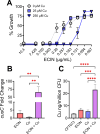Identification of a copper-responsive small molecule inhibitor of uropathogenic Escherichia coli
- PMID: 38856220
- PMCID: PMC11270900
- DOI: 10.1128/jb.00112-24
Identification of a copper-responsive small molecule inhibitor of uropathogenic Escherichia coli
Abstract
Urinary tract infections (UTIs) are a major global health problem and are caused predominantly by uropathogenic Escherichia coli (UPEC). UTIs are a leading cause of prescription antimicrobial use. Incessant increase in antimicrobial resistance in UPEC and other uropathogens poses a serious threat to the current treatment practices. Copper is an effector of nutritional immunity that impedes the growth of pathogens during infection. We hypothesized that copper would augment the toxicity of select small molecules against bacterial pathogens. We conducted a small molecule screening campaign with a library of 51,098 molecules to detect hits that inhibit a UPEC ΔtolC mutant in a copper-dependent manner. A molecule, denoted as E. coli inhibitor or ECIN, was identified as a copper-responsive inhibitor of wild-type UPEC strains. Our gene expression and metal content analysis results demonstrate that ECIN works in concert with copper to exacerbate Cu toxicity in UPEC. ECIN has a broad spectrum of activity against pathogens of medical and veterinary significance including Acinetobacter baumannii, Pseudomonas aeruginosa, and methicillin-resistant Staphylococcus aureus. Subinhibitory levels of ECIN eliminate UPEC biofilm formation. Transcriptome analysis of UPEC treated with ECIN reveals induction of multiple stress response systems. Furthermore, we demonstrate that L-cysteine rescues the growth of UPEC exposed to ECIN. In summary, we report the identification and characterization of a novel copper-responsive small molecule inhibitor of UPEC.IMPORTANCEUrinary tract infection (UTI) is a ubiquitous infectious condition affecting millions of people annually. Uropathogenic Escherichia coli (UPEC) is the predominant etiological agent of UTI. However, UTIs are becoming increasingly difficult to resolve with antimicrobials due to increased antimicrobial resistance in UPEC and other uropathogens. Here, we report the identification and characterization of a novel copper-responsive small molecule inhibitor of UPEC. In addition to E. coli, this small molecule also inhibits pathogens of medical and veterinary significance including Acinetobacter baumannii, Pseudomonas aeruginosa, and methicillin-resistant Staphylococcus aureus.
Keywords: E. coli; UPEC; antimicrobial; copper; isothiazolone.
Conflict of interest statement
The authors declare no conflict of interest.
Figures







References
Publication types
MeSH terms
Substances
Grants and funding
LinkOut - more resources
Full Text Sources
Medical

